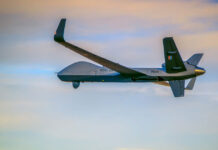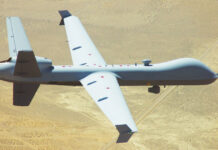The Royal Netherlands Air Force (RNLAF) has doubled the number of MQ-9A Reaper uncrewed aerial vehicles (UAVs) it is procuring from four to eight, manufacturer General Atomics Aeronautical Systems Inc (GA-ASI) announced on 21 August 2023.
The first four MQ-9A Block 5 Reapers and associated ground control stations were delivered to the RNLAF in 2022.
“We are doubling the number of MQ-9A Reapers so we can increase our maritime and overland intelligence, reconnaissance, surveillance (ISR) capacity,” Lieutenant Colonel Jan Ruedisueli, commander of the RNLAF’s 306 squadron that operate the new MQ-9As, was quoted as saying by GA-ASI. “The MQ-9As will receive external pods for electronic intelligence, a communications relay, a maritime radar, and also be armed in the future.”

The delivery of the MQ-9As, their ground control stations, and support equipment is part of a US Foreign Military Sale to the RNLAF.
“We’re thrilled that the first set of Dutch Reapers have made such a positive impact on the RNLAF,” said GA-ASI President David R Alexander. “With this new set of capabilities, the Netherlands will have the most capable set of MQ-9 Block 5 aircraft in the world. They have customised the Dutch MQ-9As to meet the Netherlands’ expanding mission set.”
The MQ-9A Block 5 has an endurance of up to 27 hours, is capable of speeds up to 240 KTAS and can operate up to an altitude of 40,000 ft. It has a 3,850 lb (1,746 kg) payload capacity that includes 3,000 lb (1,361 kg) of external stores.
Providing a long-endurance, persistent surveillance capability with full-motion video and synthetic aperture radar/moving target indicator/maritime radar, the MQ-9A Block 5 is equipped with a fault-tolerant flight control system and triple-redundant avionics system architecture.
GA-ASI says the MQ-9A “is engineered to meet and exceed manned aircraft reliability standards”.
Peter Felstead












